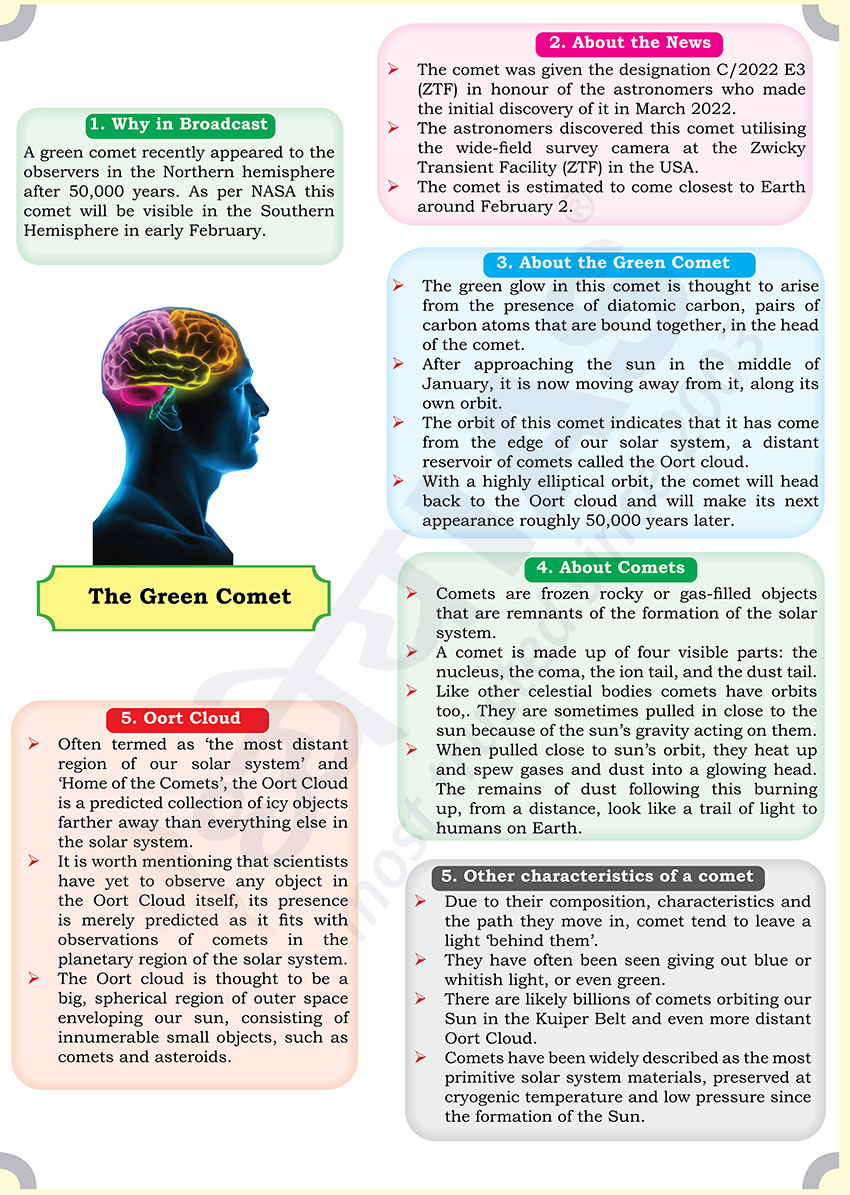Brain-booster /
14 Feb 2023
Brain Booster for UPSC & State PCS Examination (Topic: The Green Comet)

Why in Broadcast?
- A green comet recently appeared to the observers in the Northern
hemisphere after 50,000 years. As per NASA this comet will be visible in the
Southern Hemisphere in early February.
About the News
- The comet was given the designation C/2022 E3 (ZTF) in honour of the
astronomers who made the initial discovery of it in March 2022.
- The astronomers discovered this comet utilising the wide-field survey
camera at the Zwicky Transient Facility (ZTF) in the USA.
- The comet is estimated to come closest to Earth around February 2
About the Green Comet
- The green glow in this comet is thought to arise from the presence of
diatomic carbon, pairs of carbon atoms that are bound together, in the head
of the comet.
- After approaching the sun in the middle of January, it is now moving
away from it, along its own orbit.
- The orbit of this comet indicates that it has come from the edge of our
solar system, a distant reservoir of comets called the Oort cloud.
- With a highly elliptical orbit, the comet will head back to the Oort
cloud and will make its next appearance roughly 50,000 years later.
About Comets
- Comets are frozen rocky or gas-filled objects that are remnants of the
formation of the solar system.
- A comet is made up of four visible parts: the nucleus, the coma, the ion
tail, and the dust tail.
- Like other celestial bodies comets have orbits too,. They are sometimes
pulled in close to the sun because of the sun’s gravity acting on them.
- When pulled close to sun’s orbit, they heat up and spew gases and dust
into a glowing head. The remains of dust following this burning up, from a
distance, look like a trail of light to humans on Earth.
Other characteristics of a comet
- Due to their composition, characteristics and the path they move in,
comet tend to leave a light ‘behind them’.
- They have often been seen giving out blue or whitish light, or even
green.
- There are likely billions of comets orbiting our Sun in the Kuiper Belt
and even more distant Oort Cloud.
- Comets have been widely described as the most primitive solar system
materials, preserved at cryogenic temperature and low pressure since the
formation of the Sun.
Oort Cloud
- Often termed as ‘the most distant region of our solar system’ and ‘Home
of the Comets’, the Oort Cloud is a predicted collection of icy objects
farther away than everything else in the solar system.
- It is worth mentioning that scientists have yet to observe any object in
the Oort Cloud itself, its presence is merely predicted as it fits with
observations of comets in the planetary region of the solar system.
- The Oort cloud is thought to be a big, spherical region of outer space
enveloping our sun, consisting of innumerable small objects, such as comets
and asteroids.








